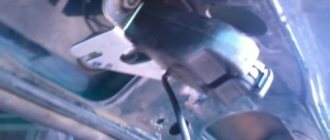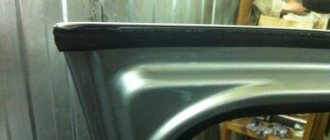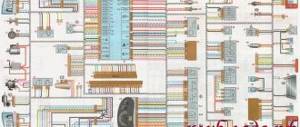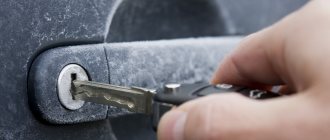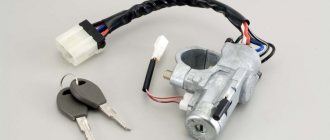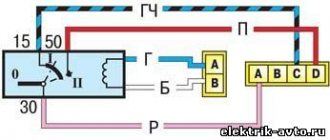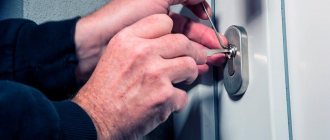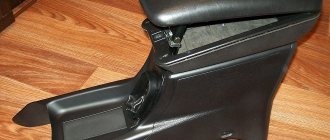Having learned the prices for central locks, I thought, is it worth buying? Maybe there is an easier way out of this situation. And I went online: I came across this diagram
For the circuit to work, you only need 2 five-contact relays, one five-wire activator (solinoid, or drive as you like :)) and 3 two-wire ones. A 5-pin relay works in the same way as a regular 4-pin relay, its peculiarity is that the central contact 87a is normally closed with contact 87, due to this the system that is used in power window buttons is repeated. As a result, when the main lock is activated, everything is activated, be it from the key or alarm :) But there is a small problem. They operate with some delay and to re-open or close you need to wait 20 seconds, but this time is selected by selecting resistors. I’ll find the official article and indicate the link :) I haven’t checked the operation of the circuit myself yet
For ease of use of vehicles, car manufacturers have long used central locking, which is a subsystem of a larger “comfort” system and is often combined with an alarm system. Central locking – locks one or all car doors. In addition, it is responsible for unlocking the fuel tank flap and trunk. If the car model is old, then the system can be installed additionally. Has remote control (RC).
How it works
The car central locking system includes:
- Input sensor: limit switches and microswitches.
- Block – central locking control.
- Actuators.
Input sensors include:
- Door limit switches – are responsible for the location of car doors, transmitting a signal to the power supply.
- Microswitches are responsible for the structural elements of the locking device.
- Two microswitches fix the cam mechanism of the front doors: one is responsible for the “lock” signal, and the other is “unlock”.
- Two more are responsible for the central locking.
- Microswitch for the lever mechanism of the lock drive.
Such a device involves transmitting a signal from microswitches first to the control unit, then to the power circuit, through which the signal goes to the doors (actuators), trunk lid and fuel tank flap. Result: the locks open.
An actuator is an actuator that causes the lock to operate.
The system operates remotely (remote control): There is a special remote control button on the ignition key, the signal is transmitted to the antenna, and from it to the unit. The range of the remote control is 10 meters. You can connect to an alarm system.
Central locking device
The central locking device includes input sensors (these are door limit switches and microswitches in the lock itself), the control unit itself and actuators - actuators. The purpose of the limit switch is to fix the door position and transmit information about it to the control unit. And microswitches, or “micriks,” as they are also called, fix the position of the structural elements of the door lock. The front doors of the car are equipped with a cam mechanism. To fix the position of the cam, the front doors have microswitches (micriks, as motorists call them) - two for each mechanism. One mikrik generates a signal about a locked lock, the second - about an unlocked one. The central locking device is equipped with two more microswitches: by analogy with the cam mechanism, one mikrik transmits a signal to the control unit about a locked lock, and the second - about an unlocked one. The fifth microswitch is installed on the lever mechanism in the lock drive. There it determines the current position of the door: when the door is open, the switch contacts close and thus the central locking system is deactivated. The signals from all microswitches are received by the electronic unit and are then transmitted to the central control unit. If necessary, or the fuel tank hatch, the central unit sends appropriate signals to the control units and influences the actuators in the locks.
Control block
The block is responsible for the operation of the lock. The control circuit includes digital elements - they transmit a signal to the rest of the system components.
This device of the car central locking system interacts with the alarm system and can also be controlled by a remote control. You can install it yourself, but most modern cars already have central locking with remote control.
The remote control operates from a separate electronic unit, which is connected to the system and controls it.
Central locking control unit and its function
The lock works as follows: when you turn the key, control contacts are activated, which send a command to the central locking control unit, and it transmits it to devices that open or lock the locks of the interior doors, luggage compartment and even the fuel tank hatch. In the event of an accident or when the airbags are deployed, all doors are unlocked automatically.
Almost everyone has already guessed that the components of central locks are a control unit and an actuator. The latter can be mechanical or pneumatic. Having decided to purchase a central locking with remote control, it is better to entrust its installation to professionals, since in this case you will receive a guarantee and be sure that the system works correctly.
Central locking functions
The advantage of a central locking device with remote control in a car:
- Save time. Instead of closing each door in turn, you need to close one - the rest are locked automatically.
- Versatility. The device is standard. There is no need to select a model.
A standard car lock kit consists of:
- Electric drive (five-wire).
- Central locking.
- Two-wire electric drives.
- Control controller.
The system is operated by a key or remote control.
- The system works with any type of alarm system.
- The remote control start button is placed on the key fob for convenience.
- If your car has an alarm system and a remote control, there is no point in ordering another one - it’s better to save money.
- In addition to the doors and hatch, you can also connect the trunk of the car. It can also be controlled by remote control.
- An important feature is the recoding of safety capabilities. For example, if the speed is exceeded, the doors are automatically locked. Or set the opening sequence: first the driver's side door, and when pressed again, the rest.
Functions of mechanisms
The small gearbox is also responsible for the operation of the actuators. For the manufacture of gearboxes, durable plastic is usually used. The signal coming from the main control unit drives the motor, and the gearbox causes the lock elements to operate. The operation of this control system is based on the following principle: the key (key fob) has a built-in microtransmitter, from which a signal is sent to the main unit, equipped with a radio antenna. The central locking with remote control is capable of interacting with the key fob at a distance of up to 15 meters on average. Once the signal for an intentional action is determined, the main unit transmits a special signal to the units responsible for opening/closing each door, after which the mechanism is turned on.
System installation
When purchasing, it is advisable to pay attention to the original kit, which is recommended by the car manufacturer, although they are not always affordable.
Most often, the choice falls on a standard universal kit, which includes:
The more expensive system is equipped with a remote control.
To install the system kit you need:
- Central locking system.
- Copper two-core wire (4 meters).
- Screwdrivers (phillips and flathead).
- Spanners.
- Ticks.
- Pliers.
- Drill + drill bits.
- Disconnect the terminals from the battery.
- Remove the door trim (remove the handle and the screws in the corners).
- Remove the plastic door screw.
- Steering wheel screws.
- Find a place to install the system (recommended - lower left corner).
- Use a drill to make holes in each door for the activators.
- Installation of lock activators, secure with self-tapping screws.
DIY installation
Installing a central locking system will take place without any particular difficulties if your car in more expensive trim levels was equipped with central locking from the factory. Then you only need to buy a factory kit: a block, activators and a corresponding wiring harness with connectors. There is no need to “collectively farm” the seats for all the mechanisms.
If you want to save money, or there are no ready-made solutions for your car, you can purchase a universal kit. This will include:
- servos;
- controller;
- wiring harness;
- fasteners.
On the market you can find both conventional systems and more expensive options with remote control.
Of course, to connect you will need a central locking circuit. You may have to drill holes for the seats. In general, installing a central lock with your own hands will not be possible without a flight of technical imagination.
Installation sequence:
Before connecting the central lock at home, carefully study the electrical circuit diagram. Without a clear understanding of the pinout and how to control the activators, it is better not to undertake installation yourself. Many modern cars are equipped with VSM. Body Control Modul is a block that controls the operation of all electrical appliances. Which can complicate the connection of the central locking with remote control and its synchronization with the rest of the electronic systems of the car.
Car safety has always been a concern for its owners, especially for those drivers who often leave their car unattended in public places or residential yards. Considering the crime rate, the desire to secure your vehicle seems quite logical. Manufacturers of modern cars, keeping this need in mind, produce cars with a built-in security system, including an alarm and automatic door locking, but the most common type remains a central locking system. Moreover, if you have an old model, in which the use of such a function was not provided for in the design, this does not mean at all that it cannot be installed additionally, and we will now tell you how to do this.
How the central lock works
– not a separate part of the car, but a combined name for all elements of the vehicle’s central locking system. Its main task is to simultaneously open or close all the doors of the car, and in some models also the fuel tank cap. Oddly enough, despite the nature of its activity, central locking is considered to be a component of a comfort system, and not a security system. It can remain operational both with the ignition on and off.
The principle of operation is as follows. When you turn the key in the keyhole of the driver's door, a microswitch is activated in it, which is responsible for locking. From it, the signal is immediately transmitted to the door control unit, and then to the central unit, where control signals are created, which are then sent to all other control units, as well as to the trunk lid and fuel tank control systems. When a signal is received, all actuators are automatically activated, which ensures instant blocking. Also, the signal sent from the microswitch to the central closing device prevents the electric drive from operating again. The reverse process (opening or unlocking) is carried out in the same way.
You can also lock all doors simultaneously using a contactless method.
To do this, there is a special button on the ignition key, when pressed, a corresponding signal is sent to the receiving antenna of the central control unit. As a result of its processing, the central device “gives a command” to all actuators and they block the vehicle doors.
Using remote locking, you activate the car alarm with one click, which has practical meaning. Also, door locking can activate automatic window lifting mechanisms, that is, using just one button, the car is “sealed” on all sides. In the event of an accident, the blocking is removed automatically: the passive safety system control unit transmits a signal to the central control unit, which ensures the appropriate reaction of the actuators (opening the doors). True, there are cases when, as a result (or immediately before it), a failure occurs in the operation of electromechanical systems, then there is no talk of automatic unlocking.
Central locking parameters and functions
By installing a central lock on your vehicle, you will greatly simplify the process of closing the car doors. Agree, getting into the cabin and closing them one by one is not very convenient, but here you will have a real opportunity to save time, since when you lock one door, the others will automatically follow suit. In principle, this function is the main one in the operation of devices of this kind.
Another positive aspect of using central locks is their versatility, which means you can’t go wrong with choosing the right model. The standard kit consists of one five-wire electric drive, the central lock itself, two-wire electric drives and a control controller. This system operates with a key and can be combined with any type of alarm system.
Manufacturers of some central locking kits also add remote controls (key fobs) to them. The principle of their operation allows you to control the door position mechanisms from a certain distance (usually no more than 10 meters), which undoubtedly simplifies use. However, if your car is already equipped with an alarm system, then it is better to save money and purchase central locking systems without a remote control, and the existing alarm remote control will help you control them.
For the most comfortable use of the vehicle, you can install a central trunk lock (activator), the main purpose of which is to open/close the trunk door
I. Just like the central locking of the interior doors, it can be controlled in two ways: through the use of a key and using the system remote control. If the driver wishes, a number of security functions of the central lock can be encoded. For example, automatic locking of the passenger compartment if the speed exceeds 60 km/h or automatic closing of the trunk if the speed is exceeded at a similar speed. In addition, the driver can program a safety opening: for example, the driver's door opens first, and only after the second attempt - all the others.
How does central locking work?
The central locking system includes input sensors, a control unit and actuators, which are called actuators. The role of input sensors is performed by vehicle door limit switches and microswitches of the lock design. The main function of the limit switch is to fix the current position of the car door and transmit the corresponding signal to the control unit.
The task of the microswitches is to determine the current position of the structural elements of the door lock.
Two more microswitches are focused on the position of the lock cam, but the cam mechanism itself is mounted only in the front doors. The operation of one microswitch creates a “Block” signal, and the second generates an “Unblock” indication. The other two microswitches remember the position of the central locking device of the lock and, when activated, create signals of its current state - “Locked” or “Unlocked”.
The operation of another microswitch is based on fixing the position of the lever mechanism of the lock drive, which determines the current position of the door. When the door opens, the switch contacts close and activation of the central locking system becomes impossible.
All microswitch signals enter the electronic control unit, which transmits them to a similar central unit. The latter, in turn, sends appropriate signals to the door control units and exerts a control effect on the actuators of the trunk lid lock and the fuel tank hatch. Having received a “command” from the central control unit, local door units activate the door lock actuators
.
The door lock actuator, or as it is also called, the actuator, is a DC electric motor that is connected to a gearbox of the simplest form. This gearbox converts the rotation of the electric motor into the reciprocating movement of the lock cylinder. Along with an electric drive, a pneumatic drive can also be used in the design of actuators. Some models from Volkswagen and Mercedes had this design, but it is currently no longer used.
Installation of central locking
Before proceeding to the direct installation of the central lock, you must first buy it; fortunately, in this regard, the choice today is quite large. It is best to pay attention to the original mechanism that the manufacturer installs on versions of cars with central locking. However, you must understand that you have to pay for quality and the price may not always be acceptable. That is why most car owners who want to have a similar system prefer to use universal kits. The standard version of such a kit includes a set of wires, cables, fasteners and the main part - the controller. More complex sets also include a control panel.
During installation, you will also need the appropriate tools
:
- automobile;
Selected central locking system;
3-4 meters of copper, two-core wire and an irreplaceable chest of tools.
The latter should include: Phillips and flat-head screwdrivers, various wrenches, cable cutting pliers, pliers, a drill and drill bits for it. Well, that’s it, if all the described tools and materials are prepared, you can proceed to the installation stage, which consists of the following steps:
1.
Remove the trim and dust curtains from each door, first disconnecting the terminals from the battery (safety first). Removing the panels is not at all difficult: unscrew the four screws from under the shelf and remove the handle, and then carefully remove the upholstery. Don’t forget about the plastic door screw; you should also unscrew it, and then remove the screws located under the steering wheel.
2.
Select a location to install the central lock. In this case, it is worth taking into account the location of the window lifter parts (it is possible that you will have to make a separate bracket for mounting). Experts advise choosing the lower left corner for installation, since when lowering the glass, it will not touch the lock and interfere with its operation.
3.
Install the lock activators. Each of them is installed separately on each door, but to do this you will first have to drill additional holes and secure them with self-tapping screws.
4.
Attach the activator to the lock rod. Considering that the stroke of the actuator rod is greater than the stroke of the lock rod, the main task is to align the center of the stroke of both rods. Then, from the activators, you need to install the clamps on the rods of the manual lock block (this is done for each door separately). Also, when connecting actuators, do not forget to check the wiring for current conductivity.
5.
Pull the wires. The wires coming from each activator can be attached to the holes using plastic clamps. It is not recommended to carry them out at the bottom of the door, since moisture most often accumulates there, and in the opening between the body and the door, which, by the way, is a problem area, it is better to use a rubber tube through passage (it can protect the wiring from chafing and kinks ).
6.
Next, remove the dashboard (preferably completely). To do this, use a screwdriver to pierce the points located next to the front panel mounting bolts and find the location of the wires (in the glove compartment and under the panel).
7.
Remove the old power window wires and install new ones, then connect them to the drive.
8.
Connect the activator drives. At the same time, insulate them and lay them inside the door, securing them with electrical tape.
9.
After the work has been done, push the wires under the dashboard on one side, and into the glove compartment on the other. Sometimes you don’t always succeed in doing this the first time, so show a little endurance and patience.
10.
Install the pass-through tube into the rack. It is best to use a screwdriver for this purpose, but be careful not to damage the rubber tube itself.
12.
Connect the central locking wire to the car: the negative wire to the body, and the positive wire to the fuse on the battery side (usually it is the first).
13.
We check the functionality of the central locking system. Connect the battery and check the device, not only its mechanical part, but also its electrical part. The movement of the rods should be easy and smooth.
14.
After checking the functionality of the mechanism, reassemble the inner door trim in reverse order and reinstall the dashboard.
It is better to pull all the wires through a special corrugated tube, which will subsequently protect them from chafing.
For the most accurate installation, the central locking rod can be bent.
In conclusion, I would like to remind you that the centralized locking system is not only a convenient way to operate a vehicle, ensuring quick opening/closing of doors, but also a good security system, which is why almost all cars produced today are equipped with it at the factory.
Subscribe to our feeds at
If you leave the car only with the doors closed with a mechanical lock, or even completely open, now, having done this, you may not find your car when you return. The issue of safe car storage is one of the most pressing for modern drivers. Driving instructors
They will talk about an important security system - central locking.
How to care for your central locking
Central locking in a car is a set of systems that provide additional convenience and safety, but it requires additional care. Problems with car locks usually arise in winter: after washing, if the locks are not properly ventilated, moisture freezes in them and grabs the rods.
To prevent this from happening, the car must be kept with the engine running, periodically forcing the locks to work, for about an hour. Or just drive around the city until the car dries out.
More information about the device and connecting the central locking in the video:
Connecting the lock to the alarm system
Connection to the alarm depends on the type of car central locking device:
- Controlled by negative impulse.
- Controlled by positive impulse.
- Controlled by a mixed impulse (almost never found).
The type of pulse determines what charge it is connected to the car alarm.
The difficulty lies in finding the necessary wires on which the pulse is determined using a probe. First you need to check the wires coming out of the door. If they are found, the door will open or close.
If the wires are not found, you need to check the central locking unit. You can find it by listening to the relay clicking. If you manage to disassemble the block and find the impulse points, the alarm is attached here.
Another possible location for the wires is at the driver's door of the car.
For the first two types of impulse, the search is the same, you just need to set the desired impulse.
Progress does not stand still; new technical solutions and developments appear every day. In the world of automotive electronics, there are already a lot of instruments and devices that can make life easier for the driver.
On foreign cars, even older ones, you can find not only an alarm system with central locking, but also heated side mirrors, an electric sunroof, heated seats and other electronic gadgets. You can only dream about this in a Zhiguli, so in this article we will tell you how to independently install a central lock on a VAZ 2101-2107, which will be controlled using an alarm system.
Central locking is a central locking system that allows you to simultaneously close or open all car doors. The system can be remote controlled and belongs to the category of vehicle auxiliary systems.
I would like to warn you right away that the article does not claim to be the best instructions or installation method. Personal experience is described here, so you always have the opportunity to do something better, more beautiful, more convenient, and so on.
Classification
The fundamental difference between central door lock control systems lies in the method of signal distribution:
- management is carried out as a single unit (centralized);
- each door has separate control units that work in tandem with the central unit (decentralized).
Central locking is a component of not only the car’s comfort system, but also an important element of passive safety. A large number of related functions that began to be assigned to the centralized door unlocking system (for example, automatic opening of all doors in the event of an accident) led to the more frequent use of systems with decentralized control.
Systems in which all functionality is implemented by a single central locking control unit are used only in budget versions. Designers have also moved away from vacuum-controlled systems. The door servo drives were controlled using a vacuum lock. Inside the latter there is a compressor that creates a vacuum or pressure in the vacuum system (unlocking and closing, respectively). Mercedes and Volkswagen liked to install similar mechanisms on their cars. Any of these designs can have a remote control (RC).
Device
The design of a car's central lock assumes the presence of:
- servo drives (motors);
- main control unit (on cars with decentralized control of additional units for each door);
- input sensors.
Conventional DC electric motors are used as actuators. The servo drive design includes:
When current is supplied, the motor shaft rotates the gear through the gear. The latter moves the rod. Damper tips soften the impact when the rod reaches dead points. The boot protects the rod from moisture, dust and dirt (an irreplaceable component if the doors inside are treated with anti-corrosion agents.
The servo drive has only two positions: “on/off”. The rod can be attached either to rods (the prerogative of universal devices) or attached directly to the door locking mechanism. A limit switch can be located inside the actuator monoblock.
It is the limit switches in the car doors and microswitches that act as input sensors. They control the position of the locking mechanism. The corresponding signal about the position of the rod is sent to the main control unit.
To fix the current position of the elements of the locking mechanism (lock), microswitches are used. The shape of the cam mechanism, which is installed only in the driver's door of the car, determines the position for the microswitches to generate a signal. Understanding the state of the lock, they send two types of signals to the control unit: (Locked) “closed” and (Unlocked) “open”.
Separate microswitches are responsible for controlling the position of the lock “tongue”. In other words, for closing the door itself. When the door is open, the switch contacts are closed. Therefore, it is impossible to activate the central locking of the car. Engaging the “tongue” on the bolt changes the position of the contacts.
The central locking control unit is an integrated pulse distributor circuit.
Opel central locking unit disassembled
What is required to install central locking on 2 doors?
- A working and installed car alarm system with power outputs for controlling door locks.
- Activators, actuators, actuators, solenoids, electric drives or, finally, just central locks - 2 pcs.
- The wires are two-core, copper. The diameter or cross-section of each wire must be at least 0.75 square. Length about 3-4 meters.
- Plastic clamps - 10 pieces, maybe more, “in reserve.”
- Other: electrical tape, heat shrink tubing, wire cutters, screwdriver, soldering iron, solder, multimeter, drill, drill bits, electrical extension cord, etc.
Before we begin directly installing central locks, we will analyze each point above in order, in more detail.
1) In this article we will not talk about how to install an alarm yourself, but we will assume that it is already installed. The cheapest option (about 1,300 rubles) is a simple alarm without feedback.
Installation and connection of central locks
Installing the central locking activator in the front door
Installation of the central lock should begin by removing the door trims and other elements that may interfere with installation. Then holes are drilled in each door to install a metal strip on which the door lock activator will be attached.
Having secured and adjusted the plastic activator, we move on to connecting and laying the wires. The task is to bring the wires into the car interior and connect them to the alarm unit.
In order to avoid moisture getting on the wires and further failure of activators and other devices (power windows, door lights), consider laying the wires along the door in advance.
Avoid placing wires at the bottom of the door, as this is where water tends to accumulate.
Central locking activator wire routing
When laying the wire, also pay attention to the most “problem” area, namely the place where the wires bend in the opening between the door and the body.
Installation of central locking
Well, the place for the lock mechanism has been chosen, you can attach it, for this you will need self-tapping screws. For correct operation, after installation, you must pair the central lock with the lock rod, which is responsible for lowering and raising the door lock button. For the most accurate fit, it is not forbidden to bend the rod. Now you need to check the movement of the mating parts, it should be light and smooth.
The next step in installing the central locking system is the wiring - pull the necessary wires through the corrugated pipe located between the door and the body pillar, which protects the wires from chafing. Following the attached instructions, connect the wires to the alarm unit.
Almost everything is ready! Now you need to check the functionality of both the mechanical and electrical parts of the installed mechanism; before doing this, do not forget to connect the battery. After making sure that everything is working properly, you should restore the casing in the reverse order indicated above and enjoy the result.
Central locking will make your driving life easier, more comfortable and safer. However, in order to avoid troubles, you should know that some such gadgets are equipped with additional options, for example, sometimes after 10 minutes the lock automatically closes all the doors, this is good if you forgot to lock the car, but bad if you also left the keys in the car. Sometimes the central locking closes the doors as soon as the driver starts the engine and presses the brake (this is more common in cars with automatic transmission).
In any case, no matter what new thing you bring to the car, be it installing an alarm system, installing parking sensors or other pleasant needs, remember about safety precautions, this will not only add comfort, but also protect you from troubles.
